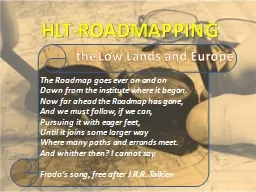

Down from the institute where it began Now far ahead the Roadmap has gone And we must follow if we can Pursuing it with eager feet Until it joins some larger way Where many paths and errands meet ID: 395738
Download Presentation The PPT/PDF document "The Roadmap goes ever on and on" is the property of its rightful owner. Permission is granted to download and print the materials on this web site for personal, non-commercial use only, and to display it on your personal computer provided you do not modify the materials and that you retain all copyright notices contained in the materials. By downloading content from our website, you accept the terms of this agreement.
Slide1
The Roadmap goes ever on and onDown from the institute where it began.Now far ahead the Roadmap has gone,And we must follow, if we can,Pursuing it with eager feet,Until it joins some larger wayWhere many paths and errands meet.And whither then? I cannot say.Frodo’s song, free after J.R.R. Tolkien
HLT-Roadmapping
the
Low
Lands and Europe Slide2
Antal van den BoschLanguage technologyMachine LearningTilburg University Arjan van HessenSpeech technologyTwente UniversityTelecats Slide3HLT Roadmaps, Then and now
HLT roadmaps in the Low Countries & EUThen, now, plans for the futureHLT: broadly or narrowly speaking?Overlap with HCI, AIApplication areas: Health, security, gamingSoftware engineeringWhither fundamental research?New roadmapsIn the African contextSlide4ELSNET Roadmap (2002)Slide5
Roadmap (technology)Fundamental HLTHLTPilotsHLTApplications
Machine Learning
Emotion detection
Image processing
Database Technology
Information Retrieval
Workflow systems
PABX
Education control
Serious
gamingSlide6
Roadmap (partners)Fundamental HLTHLTPilotsHLTApplications
UsersSlide7
1990-2000Strong focus on academic research.Collaboration of academia with the research departments of some (big) industriesResourcesCelex (1986 – 2001)Batavo (2000)Corpus Spoken Dutch (1998-2004)Twente News Corpus (1998 - )Infrastructure & NetworkingElsnet (1991 – 2004)NOTaS (2000 - )Fundamental LST-researchSPIN (NL 1988-1994)TST (NL 1995-2000)Korte Termijn Programma’s (FL)Slide8Research
Signal processingSpeech processingPhonetic researchG2PParsingSemantic webSlide9
2000-2010Technology becomes mature and usefulApplications move from the academic labs to industrial labs, (commercial) pilots and real world applications.Because basic HLT starts to work, “adjacent” technologies become interested too!Scientific programs reflect these developments: industrial partners are moving inSlide10
2000-2010ProgrammeDescriptionSponsorsIOP-MMI(1999-2009) Man-Machine InteractionIMIX (2002-2008)Interactive Multimodal Information eXtractionCATCH (2004-2008) Continuous Access to Cultural HeritageCATCH Plus (2008-2010)Transfer from CATCH-research CATCH-applicationsCATCH II (2008-2012)Moving from Cultural Heritage HumanitiesMultimediaN
(2002-2008)Solving fundamental questions of Multi-mediaNSTEVIN (2005-2011)
Dutch-Flemish Research Programme for Dutch Language and Speech TechnologySlide11Current state & near future
Because HLT is “working” (although not perfect), less money is available for fundamental HLT-researchTendency to stress what already works is strengthened by valorisation demands HLT is used as an enabling technologyIn various application areas (education, cure&care, humanities, governmental structures, safety, etc)In most new (National AND International) programmes, HLT is part of the research: not the main part of it!Again, tendency to stress what already works, to be a useful partnerSlide12From technology to clientsSlide13Be prepared
As an HLT community, be prepared to step into other large initiativesIn other areas, such asOccasional national funding possibilitiesMultidisciplinary opportunitiesWith social sciences, life sciences, exact sciences, humanitiesE.g. NWO: three areas, large-scaleResource / infrastructure fundsNWO Groot / MiddelgrootHerculesESFRISlide14
Software engineeringThere is a substantial gap betweenAcademic hacking andReal software developmentSoftware architecture designChoices of frameworks, standards, languagesProgrammingUnit testing and quality controlReleaseBug reportingMaintenanceSlide15Whither fundamental research?
HLT shares fundaments withAI, HCI, cognitive science[applied|theoretical|socio|psycho] linguisticsWe share some deep, fundamental challengesIf we want to continue being innovative, we NEED to tie in withReasoning, planning, & searchCommon sense & world knowledgeHuman factors in HCIElse, we stop being a field of innovationSlide16A fresh roadmap
For South AfricaLearning from past: Low Countries / EUSome fundamental choices:Alliances with other fieldsSoftware, resourcesFundamental research goalsUtilizing current initiativesNHN (http://www.meraka.org.za/nhn)AfLaT (http://www.aflat.org)ALT-I (http://www.alt-i.org)Bisharat (http://www.bisharat.net)Anloc (http://www.africanlocalisation.net)Slide17
The african contextLanguage technology researchers for African languages over the continent face typical, similar problems:Complex morphologyNoun classesEncodingTonalityResource-scarcenessBut no central point to access information (e.g. links, forums, publications)1 central resource point might improve visibility of African Language TechnologySlide18
AfLaT.orgCommunity-driven portal dedicated to language (and speech) technology for African languagesShare information (own work, interesting links to other people’s works)Backbone = drupal content managementSlide19Slide20Slide21Slide22Slide23Slide24
DevelopmentsSpoken Command&ControlDictation in controlled environmentsTraintable informationWhen both hands are neededSlide25
DevelopmentsSpelling controlLip readingEducational softwareAutomatic summarizationTranslation softwareSearching in large audio-dataSlide26
Real world applicationsZorg, care en cure, open democracy, education, heritage, Bio food, Road map coming from stevin demoSlide27
Oral HistoryBuchenwald
digitalized
(historic) collections
H.M. Koningin
Wilhelmina
Digital recorded collections
Second Feministic Wave
Memories of IndonesiaSlide28
Spoken and written self serviceGetting your daily newspaper if it was not delivered,by identifying yourself over the telephone (Speech Recog)In the evening the “newspaper” is calling you to ask if everything is ok.If not, a human is taking over.Slide29
Speech analiticsWhat is the reason you are of calling us?Analyzing 40K calls/per day in call centres, to tell the management why people are calling.Slide30
Real World ApplicationsGemeenteConnect: asking questions to your local authoritiesQ-A on the web: asking questions in a “natural way”HLT for dyslectic children (6 – 12 year)Monitoring elderly patients by Q-A over the phone48 other RW application recently describedSlide31
Current stateThe economic potential and societal importance of language and speech technologies in Services and ICTIn information and communication, people are naturally drawn to the means that nature gave them to express messages in natural language, and to understand the messages of others. While having embraced the computer and new ICT technologies, and having acquired the ability to use the mouse and the desktop metaphor, people still have complex desires and questions that remain best expressed in the form of words. In order to offer their services in a maximally effective way, it is vital that computers step up from their current “silent” state into being talking and understanding “intelligent systems”.Slide32
Questions?Why collaborate Low Countries and South Africa?What’s in for me/youRoadmap, but to what?Economic efficiency, social issues, educational issues?